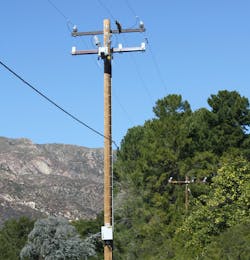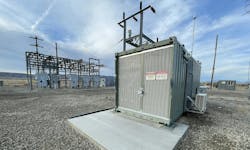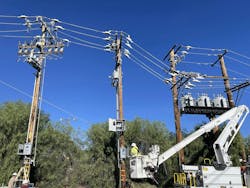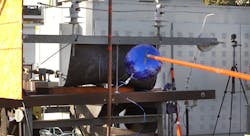SCE Reduces Faults, Lowers Risk of Wildfire Ignitions
Albert Einstein once said: “A clever person solves a problem. A wise person avoids it.” To mitigate the wildfire challenge, a utility must be both clever and wise.
Southern California Edison (SCE) continues to drive down the wildfire threat by hardening the grid to avoid or prevent faults that could result in potential ignitions. The company’s multi-layered wildfire mitigation strategy includes fault prevention and avoidance, incipient fault detection and fault energy reduction. The utility diligently performs industry benchmarking, conducts testing, and pilots hardening materials, equipment and technologies before developing design and installation standards for deployment.
The utility continues to conduct equipment inspections for repairs and maintenance, manage vegetation around power lines as well as enhance situational awareness capabilities by having one of the largest weather station networks in the country with more than 1,700 weather stations in high fire risk areas that provide wind speed, humidity and temperature data, among other variables, that is updated every 10 minutes. Furthermore, more than 180 wildfire cameras are installed in high fire risk areas [HFRA] and use artificial intelligence technology with satellite imagery to notify fire agencies about possible ignitions. The utility also uses Public Safety Power Shutoffs during extreme fire conditions as a tool of last resort.
Fault Prevention and Avoidance
Replacing bare overhead wire with covered conductor or coated electrical wire plays a critical role in the grid-hardening process as well as undergrounding power lines in severe risk areas. SCE performs various tests in both the field and laboratory to validate covered conductor performance in mitigating faults that could result in ignitions, including contact with other objects, such as animals, vegetation, metallic balloons and other conductor. To structurally support covered conductor installations, SCE calculates and validates the proper mechanical strength of existing poles to support the larger conductors. If an existing pole does not have adequate strength for covered conductor installation, SCE replaces the traditional wood pole with a fire-resistant pole, either a shielded composite pole or an intumescent-wrapped wood pole.
The pole replacement strategy provides adequate mechanical strength and resilience to the utility’s infrastructure. SCE also installs wildlife protection covers to cover exposed conductor and connections. Wood is replaced with composite crossarms, insulators and transformers as needed, and regular arresters with spark-preventing lightning arresters. SCE found on fully covered segments, there have not been any ignitions due to failure of covered conductor.
Materials and Standards
SCE conducts thorough research and development of a robust covered conductor specification to ensure effective protection against phase-to-ground and phase-to-phase faults from contact with animals, vegetation, conductor-to-conductor and metallic balloons.
Sample cable is manufactured according to SCE’s specification for testing. SCE performs comprehensive tests itself and uses an independent laboratory to demonstrate the effectiveness of covered conductor in mitigating contact faults. Meticulous test cases have been developed for each type of contact. For example, various types of tree branches and palm fronds are placed between two energized covered conductors. Video and infrared cameras are used to observe any ignition from the contact. Furthermore, each conductor is dissected at the point of contact and put under a microscope to inspect any internal damage to the insulation.
Fire-resistant (FR) poles play a key role in maintaining resiliency of the electric system in the event of a wildfire. SCE deploys two types of FR poles: composite and intumescent-wrapped wood pole. Before deploying FR poles, SCE performed rigorous testing. These tests proved the poles could withstand a typical ground fire observed in Southern California. FR poles are subjected to 1,800°F (982°C) with a frame height three times the typical chaparral height of 6 ft (1.8 m) and a duration of 3 minutes.
SCE uses FR composite poles mostly in [HFRA]. The FR composite poles serve a dual purpose of preventing ignition and withstanding a ground fire. FR composite poles are self-extinguished once a flame is removed. This helps to prevent ignition in the event of an equipment fault on a pole top. In addition, SCE uses a composite layer as a fire shield over the composite pole to increase the pole capability to withstand a typical ground fire in Southern California.
Another FR pole SCE uses is a wood pole wrapped with an intumescent layer, which becomes activated when a ground fire generates heat on the pole. This layer protects the pole from burning and falling in case of an incoming ground fire.
Incipient Fault Detection
SCE installs sensing technologies, such as early fault detection (EFD), to monitor and detect equipment defects as well as dispatch crews to validate, repair and maintain equipment. EFD sensors are installed on poles every few miles and spaced every 3 miles for distribution and 5 miles for sub-transmission lines to monitor for radio frequency discharges, which may signal a location is experiencing early signs of degradation. A circuit’s topology and length are the main drivers of installation cost for EFD. Therefore, SCE typically installs EFD in the high-risk fire portions of a circuit, thus limiting its cost. This type of sensing technology helped SCE to identify various incipient fault conditions, such as damaged insulators, broken strands, loose connectors and even vegetation contact with energized conductors. Upon receiving and verifying alarms, SCE’s operation center dispatches crews to the suspected site for visual identification and performing repairs. Successful results are validated after repair work is completed and alarms automatically cleared.
The use of new technology is not without challenges. The integration of new procedures for the technical review of alerts and responses to faults on the network is critical to the success of these technologies. With advancements in data from customer meters, greater connectivity to distribution automation equipment, distributed energy resources and monitoring systems like EFD, offer the capability to reduce faults and outages on the system to both improve electric service reliability and reduce ignition risk.
Fault Energy Reduction
It is understandable a minority of faults are unavoidable even after deploying grid-hardening work and making proactive repairs on incipient fault alarms from sensing technologies. SCE further mitigates residual ignition risks by implementing fault energy reduction technologies, such as fast curve settings, current-limiting fuses (CLF) and rapid earth fault-current limiters (REFCL).
Fast curve settings are installed on automatic recloser and circuit breaker relays that can quickly operate and remove a fault from the system. In many cases, the quick operation effectively reduces fault energy in half. Fast curve settings along with blocking of automatic reclosing operations are activated during high-risk-fire weather conditions.
CLFs are installed on small branches or a section of a circuit. A CLF is designed to reduce both fault-current magnitude and operation time. A CLF’s energy reduction varies based on fault-current levels, but generally results in a reduction of 25 times the fault energy.
The REFCL is a more advanced technology and implemented for wildfire reduction in Australia, which can increase fault sensitivity to a half ampere while reducing ground fault energy to a level that boasts a 90% ignition reduction from ground faults on three-wire systems. With REFCL protection, the fault energy of the contact between a metallic balloon and an energized conductor is significantly reduced.
Cutting Wildfire Risk
SCE’s multi-layered approach to wildfire mitigation effectively prevents and avoids contact faults, resulting in about 70% fault reduction on fully covered circuits. Sensing and fault reduction technologies have helped to further reduce ignition risks for residual faulted events, such as equipment damage and deterioration.
The ongoing deployment of covered conductor, undergrounding, enhanced inspections, expanded vegetation management and more targeted use of Public Safety Power Shutoffs (PSPS) allowed the company to achieve an 85-88% reduction in catastrophic wildfires associated with its equipment since pre-2018 levels.
Thuan Tran ([email protected]) is principal manager of asset engineering at SCE. His team is responsible for performing studies, preparing specifications, standards, and commissioning of transmission, substation and distribution electrical equipment. He holds a California Professional Engineer license in electrical engineering.
Jesse Rorabaugh ([email protected]) is a senior engineer at SCE. He received bachelor’s degrees in physics, chemistry and biology from Fresno State, a master’s degree in biomedical engineering from Cornell University and a Professional Engineer license as an electrical engineer in the state of California. He is an active IEEE member and serves as chair for the G4 working group responsible for IEEE Std. 1246 and 1268 and as vice chair for the G9 working group responsible for IEEE Std. 837.
Andrew Swisher ([email protected]) is a consulting engineer at SCE.
He earned a bachelor’s degree in electrical and computer engineering with an emphasis in power systems engineering from California State Polytechnic University at Pomona as well as a master’s degree in engineering and a certificate in power system protection and relaying from the University of Idaho. He is a registered Professional Engineer with the state of California.
About the Author
Thuan Tran
Principal Manager, T/D Apparatus & Linear Asset and Engineering Strategies
Thuan Tran is the Principal Manager for T/D Apparatus & Linear Asset and Engineering Strategies at Southern California Edison. He has been instrumental in developing the wildfire mitigation plan to combat the wildfire risks in California. He has held various positions in Distribution, Substation and System Protection Engineering groups. He was instrumental in the development of the distribution automation system for control and monitor pole-mounted switches, capacitors and automatic reclosers in the early 1990’s. As an engineer, Thuan successfully developed the specifications and commissioned a number of major projects, including Static VAR Compensators, 500 kV series capacitors, 500-220 kV Gas Insulated Switchgear (GIS).Thuan received his bachelor’s degree in electrical engineering the from the University of California, Irvine, Master’s degree in Engineering with the emphasis in Electrical Power from the University of Idaho and MBA from University of Laverne, California. He's a registered electrical engineer at the state of California. Thuan enjoys playing sports and travel.
Jesse Rorabaugh
Jesse Rorabaugh ([email protected]), P.E., is a senior engineer at Southern California Edison (SCE). He received his bachelor’s degree at California State University, Fresno with a triple major in physics, chemistry and biology followed by a master’s degree in biomedical engineering from Cornell University and a professional engineer license as an electrical engineer in California. He is an active IEEE member and serves as chair for the G4 working group responsible for IEEE Std 1246 Guide for Temporary Protective Grounding Systems Used in Substations and Std 1268 Guide for Safety in the Installation of Mobile Substation Equipment as well as vice chair for the G9 working group responsible for IEEE Std 837 Standard for Qualifying Permanent Connections Used in Substation Grounding.
Andrew Swisher
Andrew Swisher ([email protected]), P.E., is a consulting engineer at SCE. He received his bachelor’s degree from California State Polytechnic University at Pomona in electrical and computer engineering with a certification in power engineering followed by a master’s degree from the University of Idaho, Moscow with a certification in power system protection and relaying. Swisher is a licensed professional engineer registered as an electrical engineer in California.




